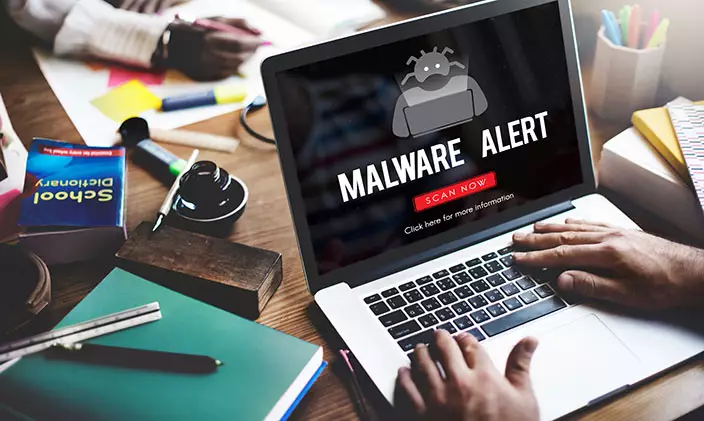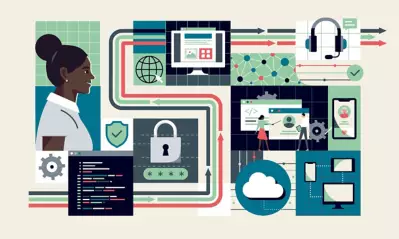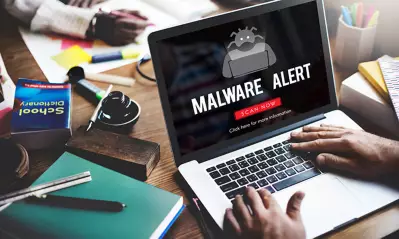Articles > Cybersecurity > Malware types and how to prevent them
Malware types and how to prevent them

Written by Michael Feder

Reviewed by Kathryn Uhles, MIS, MSP, Dean, College of Business and IT
Malware, or malicious software, is an umbrella IT term that refers to different types of intrusive computer programs that steal sensitive information or damage computer systems. Hackers commonly use malware to force their way into a device or network and compromise normal device functionality.
Malware types and prevention
As cybersecurity technology evolves, hackers are growing more aggressive in distributing hostile malware types and more clever at devising social engineering schemes to disguise malware attacks as benign messages. Today, more than 1 billion malware programs currently circulate in computer systems across the web. Though annual malware attacks are down year over year
, the attacks themselves are costly. For example, ransomware attacks cost an average of $4.54 million
in 2021.
Here are the most common malware types in circulation, along with information on how they can affect your device, and how to prevent them.
Adware
One major form of malware is adware, which will display — or even download — advertisements to a device. Adware often reaches your device through a search engine or web browser. As a malicious form of advertisement software, adware promotes unwanted ads while using a device. This can appear when using applications that don’t traditionally feature advertisements.
Adware can be prevented with a proactive approach. For example, regularly updating devices and programs and avoiding downloading files from unknown sources. Adware can also be avoided by navigating away from pop-up ads.
Fileless malware
A device’s programs can also become a cybersecurity threat because of other malware types. Fileless malware infiltrates a computer or device through legitimate applications by “piggybacking” onto scripts.
Sometimes, this happens when clicking a particular link in an email or on social media platform and fileless malware downloads onto the device. Then it waits until the application is opened to begin infecting the device, or damaging files without ever engaging with the program. Fileless malware can be hard to detect since it’s memory-based rather than file-based.
Fileless malware prevention begins with proactive standards. Avoid opening suspicious links in unfamiliar emails or on social media platforms. Consider disabling applications not actively used to limit the damage if any applications become infected. Additionally, antivirus programs provide an extra layer of defense by automatically scanning devices for fileless malware.
Viruses
A virus is malware that replicates its malicious code across a device. These programs attach themselves to common applications that might be used daily. When an application infected with a virus is opened, it can gain access to files and sensitive information.
Preventing a computer virus is relatively simple after implementing a few cybersecurity protocols. Set up complicated passwords and change them regularly. Users dealing with a large amount of sensitive information should also set up two-factor authentication, which allows access to a platform only after verifying a user's identity multiple times.
Worms
Computer worms infect devices and quickly self-replicate, compromising performance while identifying and infecting connected devices. Worms typically access a device’s network and move laterally across all other devices in that system. Once a worm exploits a security issue on a single device (the “host”), it can infect other devices — even if those secondary devices are fully protected. The highest-functioning worms can replicate across many devices , servers and networks without human interaction.
Many firewalls and antivirus programs offer strong worm protection and can help identify suspicious items in emails or other forms of messaging. Worm prevention becomes more challenging after worms infect a network. Even if you eliminate many of the worms infecting secondary devices, the worms can continue to replicate until the host device is cleansed.
The bad news? Remnants of worm activity can affect productivity across your networks long after the worm is removed. Because of the potential for damage from a computer worm, many organizations turn to professional cybersecurity assistance.
Trojans
Trojans, or Trojan horses, are virtually any malware types that mislead users. Trojan code maliciously takes control of a device after disguising itself as a legitimate computer program.
Users will notice device performance issues soon after a Trojan arrives. If a computer or phone displays interruptive pop-ups or spam messages, it might be infected.
To prevent Trojan malware:
- Refrain from downloading files from unrecognized sources don’t recognize.
- Don’t open attachments or links in unfamiliar emails.
- Perform updates and download the latest security patches for devices and all programs.
Bots
Bots represent malicious malware types -- programs that hackers use to control devices. Malware bots can resemble legitimate bots that search engines use to perform repetitive tasks. In the same way Googlebot indexes webpages, a malicious bot repeatedly crawls a device or website for valuable information.
Preventing bots means protecting devices and websites from malicious crawls. To protect a device, consider installing a strong antivirus program that limits a bot’s entry points and automatically crawls running processes for unauthorized activity.
To protect user-facing webpages from harm:
- Block outdated browsers from accessing websites.
- Take time to evaluate traffic sources through data-tracking tools to identify where website traffic enters and exits a website.
- Pay close attention to failed website login attempts and investigate unexpected spikes or drops in page visits.
Ransomware
Ransomware is a form of malware that takes hostile control of files or devices, blocking access until a ransom is paid. Hackers often threaten to erase a device’s data unless ransom demands are met. In other cases, hackers threaten to make the device’s information public.
Ransomware works by encrypting a device, or specific files within a device, and preventing user access. Soon after, hackers make the ransom demand.
Preventing ransomware starts with healthy device-use habits:
- Don’t download files and applications from unknown sources.
- Review port settings regularly and use virus scanners familiar with common ransomware programs.
- Maintain backup files in case original documents become locked. Backup files give leverage in a ransomware situation and may provide enough time for professional IT specialists to assist with recovery.
Spyware
Among malware types, spyware is far more discreet than many other forms of malware. It transmits personal information directly from a hard drive to other locations.
Unlike bots or worms, spyware is typically distributed to specific devices for specific purposes. Hackers might be searching for incriminating information they think is on a user’s hard drive, or mining for a particular set of login credentials.
Spyware is challenging to identify since its primary goal is to hide on a device. Spyware resembles other forms of malware in how it affects a device. Users might notice slower application load times, slower internet processing times and unexpected program crashes. In addition, spyware can cause unexplainable increases in a device’s data use.
It’s much easier to prevent spyware than to eradicate spyware once it begins to affect your device. Preventing spyware means practicing safe internet and email habits, monitoring device data-usage trends and the permissions you allow for each application.
Rootkits
Rootkits are designed to grant hackers undetectable access to a device. Unlike worms and viruses, which depend on sheer volume to overwhelm a device, rootkits are targeted attacks by hackers attempting to avoid detection.
Rootkits commonly appear on devices through phishing, or mass link distribution schemes across email and social media platforms.
Once integrated into a device, a rootkit can begin disrupting it in several ways. Because rootkits commonly give hackers remote access, users might notice applications operating without their control.
To prevent rootkits from accessing a device:
- Avoid suspicious emails, text messages or other outreach from unfamiliar sources.
- Avoid downloading untrusted software or software from third-party websites or vendors.
- Regularly update the programs on devices.
If you suspect a rootkit has infected a device, disconnect from the internet immediately. Hackers can create a link to a device through their internet connection, directly accessing files until the connection is broken.
Learn more about malware types and other cybersecurity threats
Whether you’re seeking to prevent different malware types, gain a basic understanding of cybersecurity or you’re a working professional looking to expand your skill set, University of Phoenix offers online course collections and bachelor’s and master’s degrees in cybersecurity and more:
- Certified Ethical Hacker Course Collection
- Certified Incident Handler Course Collection
- Certified Network Defender Course Collection
- Computer Hacking Forensics Investigator Course Collection
- Bachelor of Science in Cybersecurity
- Master of Science in Cybersecurity
Contact University of Phoenix for more information .

ABOUT THE AUTHOR
A graduate of Johns Hopkins University and its Writing Seminars program and winner of the Stephen A. Dixon Literary Prize, Michael Feder brings an eye for detail and a passion for research to every article he writes. His academic and professional background includes experience in marketing, content development, script writing and SEO. Today, he works as a multimedia specialist at University of Phoenix where he covers a variety of topics ranging from healthcare to IT.

ABOUT THE REVIEWER
Currently Dean of the College of Business and Information Technology, Kathryn Uhles has served University of Phoenix in a variety of roles since 2006. Prior to joining University of Phoenix, Kathryn taught fifth grade to underprivileged youth in Phoenix.
This article has been vetted by University of Phoenix's editorial advisory committee.
Read more about our editorial process.



